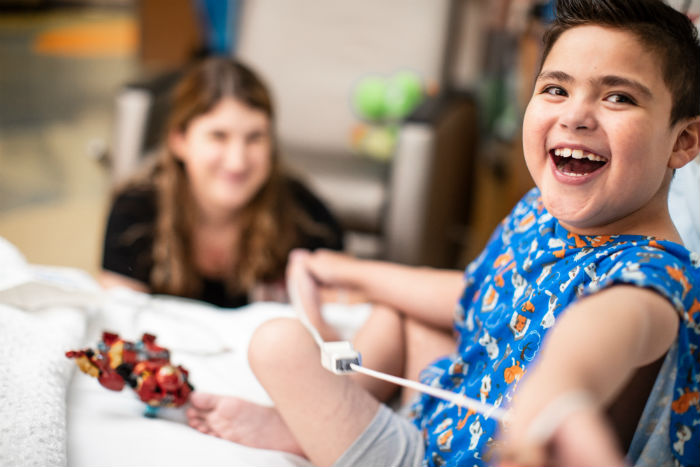Condition
Pediatric Diaphragmatic Hernia
A diaphragmatic hernia is a birth defect, which is an abnormality that occurs before birth as a fetus is forming in the mother's uterus. An opening is present in the diaphragm (the muscle that separates the chest cavity from the abdominal cavity). With this type of birth defect, some of the organs that are normally found in the abdomen move up into the chest cavity through this abnormal opening.
There are two types of diaphragmatic hernia:
- Bochdalek hernia. A Bochdalek hernia usually involves an opening on the left side of the diaphragm. The stomach, liver, spleen, and/or intestines usually move up into the chest cavity.
- Morgagni hernia. A Morgagni hernia involves an opening on the middle or right side of the diaphragm. The liver and/or intestines usually move up into the chest cavity.
Causes of diaphragmatic hernia:
As a fetus is growing in its mother's uterus before birth, different organ systems are developing and maturing. The diaphragm develops between the seventh and 12th week of pregnancy. The esophagus (the tube that leads from the throat to the stomach), the stomach, and the intestines are also developing at this time.
In a Bochdalek hernia, the diaphragm may not develop properly, and the intestine may become trapped in the chest cavity as a result.
In a Morgagni hernia, the tendon that should develop in the middle of the diaphragm does not develop properly.
In both cases, normal development of the diaphragm does not occur.
Diaphragmatic hernia is a multifactorial condition, which means that "many factors," both genetic and environmental, are involved. It is thought that multiple genes from both parents, as well as a number of environmental factors that scientists do not yet fully understand, contribute to diaphragmatic hernia.
Bochdalek hernia makes up about 80 to 90 percent of all cases.
Morgagni hernia makes up 2 percent of all cases.
Why diaphragmatic hernia is of concern:
The lungs are developing at the same time as the diaphragm and the digestive system. A diaphragmatic hernia allows abdominal organs to move into the chest cavity, instead of remaining in the abdomen as they are developing. With the heart, lungs, and abdominal organs all taking up space in the chest cavity, the lungs do not have space to develop properly. This underdevelopment of the lungs is called pulmonary hypoplasia.
A diaphragmatic hernia is a life-threatening illness. When the lungs do not develop properly during pregnancy, it can be difficult for the baby to breathe after birth. Healthy lungs have millions of small air sacs (alveoli), which resemble a balloon filled with air. In infants with pulmonary hypoplasia:
- There are fewer air sacs than normal.
- The air sacs that are present are able to only partially fill with air.
- The air sacs deflate easily due to a lack of a lubricating fluid called surfactant.
When these conditions are present, the baby is unable to take in enough oxygen to stay healthy.
Symptoms of a diaphragmatic hernia:
The symptoms of a Bochdalek diaphragmatic hernia are often seen soon after the baby is born. The following are the most common symptoms of a Bochdalek diaphragmatic hernia. However, each child may experience symptoms differently. Symptoms may include:
- Difficulty breathing
- Fast breathing
- Fast heart rate
- Cyanosis (blue color of the skin)
- Abnormal chest development, with one side being larger than the other
- Abdomen that appears caved in (concave)
A baby born with a Morgagni hernia may or may not show any symptoms.
The symptoms of diaphragmatic hernia may resemble other conditions or medical problems. Always consult your baby's doctor for a diagnosis.
How a diaphragmatic hernia is diagnosed:
After birth, your baby's doctor will perform a physical examination. A chest X-ray is done to look at the abnormalities of the lungs, diaphragm, and intestine. A blood test known as an arterial blood gas is often performed to evaluate the baby's breathing ability.
Other tests that may be performed include:
- Blood test for chromosomes (to determine if there is a genetic problem).
- Ultrasound of the heart (echocardiogram).
Treatment for a diaphragmatic hernia:
Specific treatment will be determined by your baby's doctor based on the following:
- When the problem is diagnosed (during pregnancy or after birth)
- Your baby's overall health and medical history
- The severity of the problem
- Your baby's tolerance for specific medications, procedures, or therapies
- Your opinion or preference
Treatment may include:
- Neonatal intensive care. A diaphragmatic hernia is a life-threatening illness and requires care in a neonatal intensive care unit (NICU). Babies with diaphragmatic hernia are often unable to breathe effectively on their own because their lungs are underdeveloped. Most babies will need to be placed on a breathing machine called a mechanical ventilator to help their breathing.
- ECMO (extracorporeal membrane oxygenation). Some infants may need to be placed on a temporary heart/lung bypass machine called ECMO if they have severe problems. ECMO does the job that the heart and lungs would be doing--putting oxygen in the bloodstream and pumping blood to the body. ECMO may be used temporarily while a baby's condition stabilizes and improves.
- Surgery. When the baby's condition has improved with the help of the NICU team, the diaphragmatic hernia will be repaired with an operation. The stomach, intestine, and other abdominal organs are moved from the chest cavity back to the abdominal cavity. The hole in the diaphragm is repaired. This may be accomplished either by an open operation (laparotomy) or a minimally invasive surgical approach either through the chest (thoracoscopy) or abdomen (laparoscopy). Advantages of minimally invasive procedures in infants include less pain, less scarring, shorter hospital stays, and fewer problems with scar tissue leading to intestinal blockages in the future compared to open surgery.
Many babies will need to remain in the NICU for a while after surgery. Although the abdominal organs are now in the right place, the lungs still remain underdeveloped. The baby will usually need to have breathing support for a period of time after the operation. Once the baby no longer needs help from a breathing machine (ventilator), he or she may still need oxygen and medications to help with breathing for weeks, months, or years.
Can there be problems in the future?
Babies born with diaphragmatic hernia can have long-term problems and often need regular follow-up after going home from the hospital.
Many babies will have chronic lung disease and may require oxygen or medications to help their breathing for weeks, months, or years.
Many babies will have gastroesophageal reflux. Acid and fluids from the stomach move up into the esophagus (the tube that leads from the throat to the stomach), and can cause heartburn, vomiting, feeding problems, or lung problems. Gastroesophageal reflux can often be controlled with medications or by a minimally invasive surgical antireflux procedure known as a fundoplication.
Some babies will have difficulty growing. This is known as failure to thrive. The children with the most serious lung problems are most likely to have growing problems. Because of their illness, they often require more calories than a normal baby in order to grow and get healthier. Gastroesophageal reflux can also cause feeding problems, preventing a baby from eating enough to grow.
Some babies can have developmental problems. They may not roll over, sit, crawl, stand, or walk at the same time other babies do. Physical therapy, speech therapy, and occupational therapy are often helpful for these babies to gain muscle strength and coordination.
Some babies may have some degree of hearing loss. A hearing test should be performed prior to discharge from the hospital.
Each child and illness is different, so it is important to talk to your baby’s medical team for information on your child’s prognosis.
Providers Who Treat Diaphragmatic Hernia
 Aasha's Rare Gift Will Help Other Babies Grow up Healthy
Aasha's Rare Gift Will Help Other Babies Grow up HealthyTesting the descrption field
Departments that Treat Diaphragmatic Hernia

Rare Disease Institute
Children’s National Rare Disease Institute (CNRDI) is a first-of-its-kind center focused exclusively on advancing the care and treatment of children and adults with rare genetic diseases.





